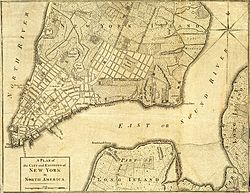Greenwich Street (Manhattan)



The Greenwich Street is running in a north-south direction road in the south of New York City's borough Manhattan , USA . It extends between the intersection of Ninth Avenue and Gansevoort Street in the Meatpacking District to the north and Battery Park to the south.
Location and course
Greenwich Street is in downtown Manhattan .
North of Spring Street , Greenwich Street runs as a one-way street to the north and south of Spring Street as a one-way street to the south. The main streets that cross Greenwich Street are (north to south): Christopher Street , Houston Street , Canal Street, and Chambers Street .
Between Vesey Street and Liberty Street , it is interrupted by the World Trade Center site . As part of the rebuilding of the World Trade Center site, the road should be able to run through this section again without interruption. Sometimes this street is mistaken for Greenwich Avenue . However, some of the new skyscrapers at the World Trade Center have house numbers on Greenwich Street.
Greenwich Street runs through a few neighborhoods such as the Meatpacking District, the West Village , Hudson Square and Tribeca .
history
The earliest evidence of Greenwich Street is from the 1790s when it ran parallel to the Hudson River. At that time it was called Road to Greenwich because it was the only continuous road connection from Lower Manhattan to Greenwich Village next to Broadway .
In the late 18th century, the southern part of Greenwich Street was part of one of the most modern residential areas in the city, with four-story federal-style houses on either side. In the north, however, lived artisans and business owners and a few free blacks. Greenwich Street was a sought-after residential address well into the 1820s, but by the 1850s wealthy residents had moved to uptown and private houses on the street had become rare. One of those who stayed for a while was the hotel owner Amos Eno until he left, as his daughter reported, when he was "surrounded by guesthouses full of immigrants". In 1873 the Butter and Cheese Exchange settled on the road, not far from where the daily dairy products arrived at the freight stations. In 1882 the New York Steam Company built a plant at the intersection of Greenwich and Dey Streets.
Local transport
Greenwich Street was one of the first streets over which elevated railways were tested in the late 1860s. The IRT Ninth Avenue Line , which was demolished in the 1940s, also operated here.
The IRT Broadway - Seventh Avenue Line runs from Vesey Street under Greenwich Street to its southern end.
The stops Cortlandt Street (IRT Broadway - Seventh Avenue Line) and Rector Street (IRT Broadway - Seventh Avenue Line) provide direct access to Greenwich Street. Other New York subway stops can be found near Greenwich Street.
The World Trade Center Transportation Hub is currently being built between Greenwich Street and Church Street to connect five subway stations at the World Trade Center site.
The M11 bus runs north on Greenwich Street from Bethune Street to Gansevoort Street. The M8 bus crosses Greenwich Street in both directions: at Christopher Street to the west and at West 10th Street to the east. The M21 bus also crosses Greenwich Street in both directions. Head west at Houston Street and east at Spring Street.
Buildings
Web links
- New York Songlines: Ninth Avenue with Greenwich Street (English) - a virtual walk